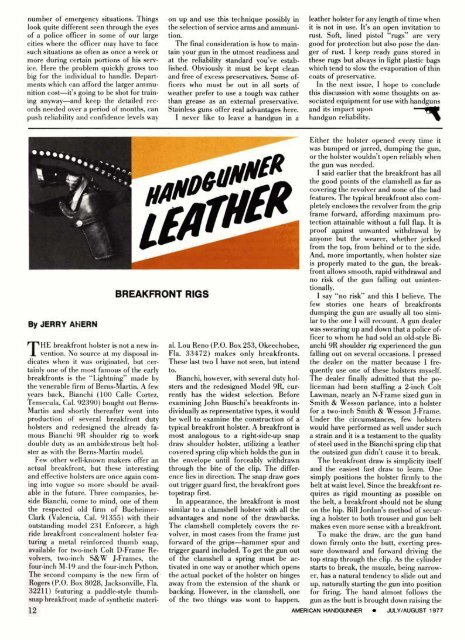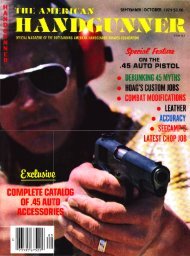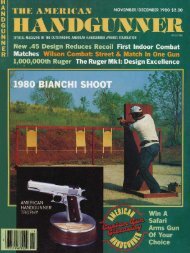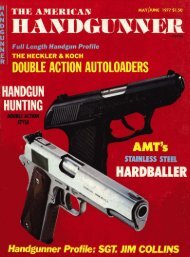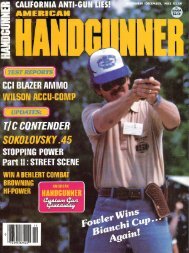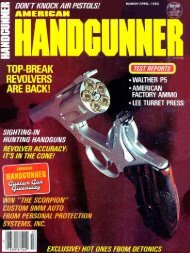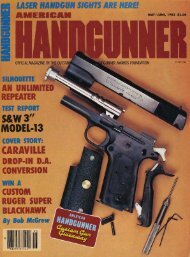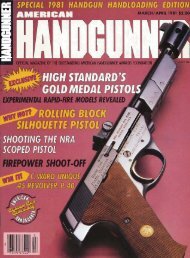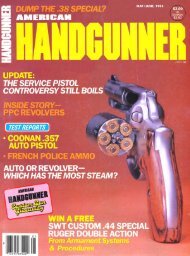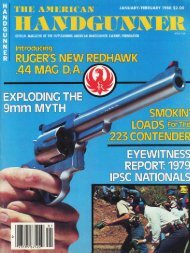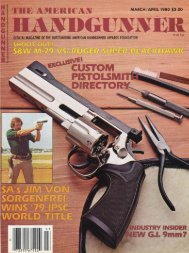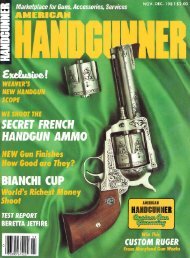American Handgunner July/August 1977
American Handgunner July/August 1977
American Handgunner July/August 1977
Create successful ePaper yourself
Turn your PDF publications into a flip-book with our unique Google optimized e-Paper software.
number of emergency situations. Thingslook quite different seen through the eyesof a police officer in some of our largecities where the officer may have to facesuch situations as often as once a week ormore during certain portions of his service.Here the problem quickly grows toobig for the individual to handle. Departmentswhich can afford the larger ammunitioncost-it's going to be shot for traininganyway-and keep the detailed recordsneeded over a period of months, canpush reliability and confidence levels wayon up and use this technique possibly inthe selection of service arms and ammunition.The final consideration is how to maintainyour gun in the utmost readiness andat the reliability standard you've established.Obviously it must be kept cleanand free of excess preservatives. Some officerswho must be out in all sorts ofweather prefer to use a tough wax ratherthan grease as an external preservative.Stainless guns offer real advantages here.I never like to leave a handgun in aleather holster for any length of time whenit is not in use. It's an open invitation torust. Soft, lined pistol "rugs" are verygood for protection but also pose the dangerof rust. I keep ready guns stored inthese rugs but always in light plastic bagswhich tend to slow the evaporation of thincoats of oreservative.In the next issue, I hope to concludethis discussion with some thoughts on associatedequipment for use with handgunsand its impact uponhandgun reliability.BREAKFRONT RIGSBy JERRY AHERNHE breakfront holster is not a new in-T vention. No source at my disposal indicateswhen it was originated, but certainlyone of the most famous of the earlybreakfronts is the "Lightning" made bythe venerable firm of Berns-Martin. A fewyears back, Bianchi (100 Calle Cortez,Temecula, Cal. 92390) bought out Berns-Martin and shortly thereafter went intoproduction of several breakfront dutyholsters and redesigned the already famousBianchi 9R shoulder rig to workdouble duty as an ambidextrous belt holsteras with the Berns-Martin model.Few other well-known makers offer anactual breakfront, but these interestingand effective holsters are once again cominginto vogue so more should be availablein the future. Three companies, besideBianchi, come to mind, one of themthe respected old firm of Bucheimer-Clark (Valencia, Cal. 91355) with theiroutstanding model 231 Enforcer, a highride breakfront concealment holster featuringa metal reinforced thumb snap, forward of the grips-hammeravailable for two-inch Colt D-Frame Revolvers,two-inch S&W J-Frames, thefour-inch M-19 and the four-inch Python.The second company is the new firm of-Rogers (P.O. Box 8028, Jacksonville, Fla.32211) featuring a paddle-style thumbsnapbreakfront made of synthetic materi-al. Lou Reno (P.O. Box 253, Okeechobee,Fla. 33472) makes only breakfronts.These last two I have not seen, but intendto.Bianchi, however, with several duty holstersand the redesigned Model 9R, currentlyhas the widest selection. Beforeexamining John Bianchi's breakfronts individuallyas representative types, it wouldbe well to examine the construction of atypical breakfront holster. A breakfront ismost analogous to a right-side-up snapdraw shoulder holster, utilizing a leathercovered spring clip which holds the gun inthe envelope until forceably withdrawnthrough the bite of the clip. The differencelies in direction. The snap draw goesout trigger guard first, the breakfront goestopstrap first.In appearance, the breakfront is mostsimilar to a clamshell holster with all theadvantages and none of the drawbacks.The clamshell completely covers the revolver,in most cases from the frame justspur andtrigger guard included. To get the gun outof the clamshell a spring must be activatedin one way or another which opensthe actual pocket of the holster on hingesaway from the extension of the shank orbacking. However, in the clamshell, oneof the two things was wont to happen.Either the holster opened every time itwas bumped or jarred, dumping the gun,or the holster wouldn't open reliably whenthe gun was needed.I said earlier that the breakfront has allthe good points of the clamshell as far ascovering the revolver and none of the badfeatures. The typical breakfront also completelyencloses the revolver from the gripframe forward, affording maximum protectionattainable without a full flap. It isproof against unwanted withdrawal byanyone but the wearer, whether jerkedfrom the top, from behind or to the side.And, more importantly, when holster sizeis properly mated to the gun, the breakfrontallows smooth, rapid withdrawal andno risk of the gun falling out unintentionally.I say "no risk" and this I believe. Thefew stories one hears of breakfrontsdumping the gun are usually all too similarto the one I will recount. A gun dealerwas swearing up and down that a police officerto whom he had sold an old-style Bianchi9R shoulder rig experienced the gunfalling out on several occasions. I pressedthe dealer on the matter because I frequentlyuse one of these holsters myself.The dealer finally admitted that the policemanhad been stuffing a 2-inch ColtLawman, nearly an N-Frame sized gun inSmith & Wesson parlance, into a holsterfor a two-inch Smith & Wesson J-Frame.Under the circumstances, few holsterswould have performed as well under sucha strain and it is a testament to the qualityof steel used in the Bianchi spring clip thatthe outsized gun didn't cause it to break.The breakfront draw is simplicity itselfand the easiest fast draw to learn. Onesimply positions the holster firmly to thebelt at waist level. Since the breakfront requiresas rigid mounting as possible onthe belt, a breakfront should not be slungon the hip. Bill Jordan's method of securinga holster to both trouser and gun beltmakes even more sense with a breakfront.To make the draw, arc the gun handdown firmly onto the butt, exerting pressuredownward and forward driving thetop strap through the clip. As the cylinderstarts to break, the muzzle, being narrower,has a natural tendency to slide out andup, naturally starting the gun into positionfor firing. The hand almost follows thegun as the butt is brought down raising the12 AMEF 11CAN HANDGUNNER JULY/AUGUST <strong>1977</strong>


